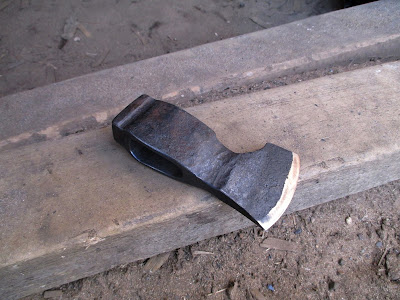This axe head starts it's life as a piece of truck leaf spring. Cut off with an angle grinder and then annealed.
Then I drill a pivot hole for the eye drift. This is not necessary of course, but helps when punching the eye. Especially when working alone, and without power hammer or press.
Punching the eye. Takes many heats to get it done.
Eye done.
Starting to form the blade, for this I wanted some beard, and a bit of thinning behind the bevel to reduce weight.
Blade bit and poll are forged in shape.
Corners filed down and shape finished, edge sanded ready for heat treatment.
Edge is hardened in oil, then immediately tempered on glowing coal of the forge. When tempering is finished the whole head is dipped in tar and excess is wiped off.
Then it's time to start with the handle. Shape is drawn and cut off with a jigsaw. This time I used white ash. I still have some planks left from the time I used to make bows. Good material for tool handles.
Rest of the handle work is done with rasp, file, and sandpaper. First the eye part is fitted, leaving last half a centimeter to be hammered in when finally fixing the head.
I like to use cross wedges, so next thing was to saw two slots for them, and whittle the wedges from juniper. Before the handle is finally fixed I sanded the edge of the bit, and finished the handle with coarse sandpaper.
Then just fitted the handle in it's place, hammered wedges in with some wood glue, and let it dry. Next day it got some boiled linseed oil for protection, as well for the head itself.
This axe came out weighing about 800 grams, with a total lenght of 40cm. Edge is about 7cm. Decent size for my needs.
 Most often around the area where I live I use stumps and roots of a fallen pine for campfire. From these you can pretty easily find fatwood, which lights up easily even in the rain. Downside with them is that they can have some rocks between the roots, so you easily damage the edge of your axe even when being careful. Stumps with roots won't always split easily, so I like my axe handle to be relatively thick, especially on the neck, so I can sometimes bend it bit sideways too. On the other hand it can't be too thick for grabbing it just below the head still.
Most often around the area where I live I use stumps and roots of a fallen pine for campfire. From these you can pretty easily find fatwood, which lights up easily even in the rain. Downside with them is that they can have some rocks between the roots, so you easily damage the edge of your axe even when being careful. Stumps with roots won't always split easily, so I like my axe handle to be relatively thick, especially on the neck, so I can sometimes bend it bit sideways too. On the other hand it can't be too thick for grabbing it just below the head still.
I'm not that strict with bevel/edge geometry of my outdoor axe. Usually I use flat bevel with a secondary, convex works too. This is not a carving axe, so splitting properties are more important than being able to carve nicely.
I'm not a fan of sharp or pointed lower corner/heel of the bit, so bearded design gives more obtuse corned without adding weight. Also a flat poll is important for me, for example to drive tent stakes to the ground.
Future will show if this axe is to my liking in the woods.















Sweet!!!
ReplyDeleteGreat hatchet! I like the bearded design and the handle shape as well. It definitely looks like a hatchet well suited to your location and wood-processing jobs. Well done!
ReplyDeleteThanks guys!
ReplyDeleteVery nice hatchet. That's a great benefit of having your skill skill set in making tools, and being an experienced user of them as well. You know what you like and what works well for you, and you have the ability to design your tools to meet your needs.
ReplyDeleteThanks Bradley. Yeah, it's a benefit for sure to be able to make your own tools. And if you're not happy with some feature in them, just look in the closest mirror and you'll see the reason for it. Then just make the changes you need in the tool.
ReplyDelete